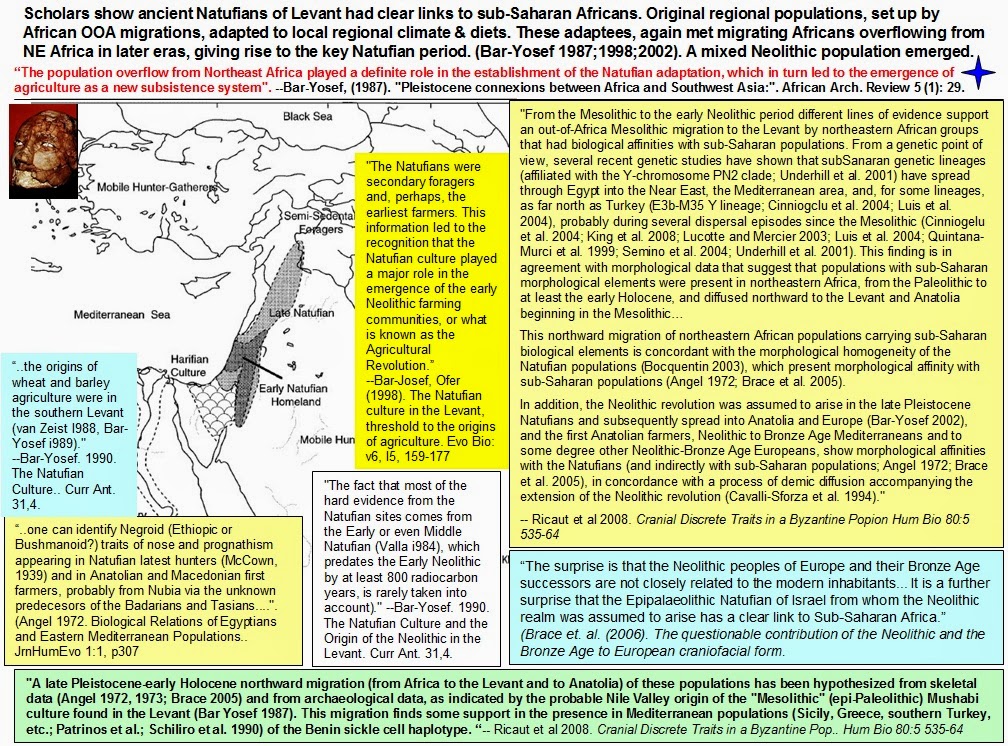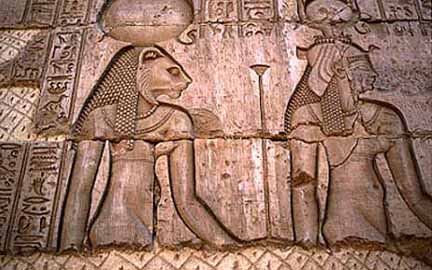Who were the Natufian pioneers of the Neolithic?
Mar 23, 2013 17:04:36 GMT -5
ftballplaya likes this
Post by zarahan on Mar 23, 2013 17:04:36 GMT -5

Scholars show early Middle Easterners like the Natufians, while not absolutely identical, had clear links to tropical sub-Saharan African types. The Natufians were key players in the Neolithic advance. Key early migrations into the Levant & parts of Europe would be by these tropicals not Asiatics, Europeans, or Arab types.
"From the Mesolithic to the early Neolithic period different lines of evidence support an out-of-Africa Mesolithic migration to the Levant by northeastern African groups that had biological affinities with sub-Saharan populations. From a genetic point of view, several recent genetic studies have shown that subSanaran genetic lineages (affiliated with the Y-chromosome PN2 clade; Underhill et al. 2001) have spread through Egypt into the Near East, the Mediterranean area, and, for some lineages, as far north as Turkey (E3b-M35 Y lineage; Cinniogclu et al. 2004; Luis et al. 2004), probably during several dispersal episodes since the Mesolithic (Cinniogelu et al. 2004; King et al. 2008; Lucotte and Mercier 2003; Luis et al. 2004; Quintana-Murci et al. 1999; Semino et al. 2004; Underhill et al. 2001). This finding is in agreement with morphological data that suggest that populations with sub-Saharan morphological elements were present in northeastern Africa, from the Paleolithic to at least the early Holocene, and diffused northward to the Levant and Anatolia beginning in the Mesolithic…
This northward migration of northeastern African populations carrying sub-Saharan biological elements is concordant with the morphological homogeneity of the Natufian populations (Bocquentin 2003), which present morphological affinity with sub-Saharan populations (Angel 1972; Brace et al. 2005).
In addition, the Neolithic revolution was assumed to arise in the late Pleistocene Natufians and subsequently spread into Anatolia and Europe (Bar-Yosef 2002), and the first Anatolian farmers, Neolithic to Bronze Age Mediterraneans and to some degree other Neolithic-Bronze Age Europeans, show morphological affinities with the Natufians (and indirectly with sub-Saharan populations; Angel 1972; Brace et al. 2005), in concordance with a process of demie diffusion accompanying the extension of the Neolithic revolution (Cavalli-Sforza et al. 1994)."
-- Ricaut et al 2008. Cranial Discrete Traits in a Byzantine Popion Hum Bio 80:5 535-64
“..one can identify Negroid (Ethiopic or Bushmanoid?) traits of nose and prognathism appearing in Natufian latest hunters (McCown, 1939) and in Anatolian and Macedonian first farmers, probably from Nubia via the unknown predecesors of the Badarians and Tasians....". (Angel 1972. Biological Relations of Egyptians and Eastern Mediterranean Populations.. JrnHumEvo 1:1, p307
"Analyses showed that the Natufian dentiton was much like the more recent Southern Levant people as well as Holocene Nubians.” -- Turner (2008) "A dental anthropological hypothesis relating to the ethnogenesis. p. 21-25.
“The surprise is that the Neolithic peoples of Europe and their Bronze Age successors are not closely related to the modern inhabitants... It is a further surprise that the Epipalaeolithic Natufian of Israel from whom the Neolithic realm was assumed to arise has a clear link to Sub-Saharan Africa.” (Brace et. al. (2006). The questionable contribution of the Neolithic and the Bronze Age to European craniofacial form.
"A late Pleistocene-early Holocene northward migration (from Africa to the Levant and to Anatolia) of these populations has been hypothesized from skeletal data (Angel 1972, 1973; Brace 2005) and from archaeological data, as indicated by the probable Nile Valley origin of the "Mesolithic" (epi-Paleolithic) Mushabi culture found in the Levant (Bar Yosef 1987). This migration finds some support in the presence in Mediterranean populations (Sicily, Greece, southern Turkey, etc.; Patrinos et al.; Schiliro et al. 1990) of the Benin sickle cell haplotype. “-- Ricaut et al 2008. Cranial Discrete Traits in a Byzantine Pop.. Hum Bio 80:5 535-64








 LOLOLOLOLOL
LOLOLOLOLOL
